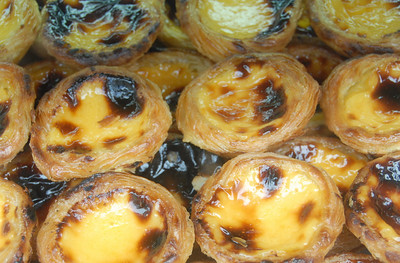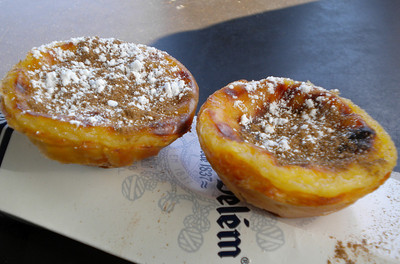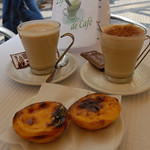
Spend a week in Portugal and no doubt you’ll end up with a serious addiction to pasteis de natas. Sweet and creamy yet with a slight crunch, these small custard tarts line the windows of most bakeries and coffee shops. The locals blanket them with cinnamon and a smidgen of powdered sugar before consuming them at breakfast or as a snack. In my case no day in Portugal was complete without at least one of these bite-sized treats.
Although I found them throughout Portugal, legend has it that de natas originated on the outskirts of Lisbon, at Belem’s Mosteiro dos Jerónimos. There lay bakers produced pasteis de natas for the general public. In the early 19th century, when the monastery closed, a neighboring confectioner, Domingo Rafael Alves, bought the recipe from one of the out-of-work bakers and started offering them in his shop.

Today Alves’ Pasteis de Belem has become a tourist attraction in its own right. Made using the monastery’s original, secret recipe, Pasteis de Belem’s tarts draw countless customers to the cafe seven days per week. On the late afternoon that I visited, a dozen people lined the stone sidewalk outside, patiently waiting for their turn to buy boxes of this delectable sweet. Just remember that here they are called pasteis de Belem while everywhere else they’re known as pasteis de nata.
What makes this pastry so delicious? Perhaps it’s the de nata’s light shell. Reminiscent of puff pastry, its airy crispness provides the perfect contrast to a velvety custard. Then again, maybe it’s the custard. Whipped together from fresh cream, egg yolks and sugar, its warm, gentle flavor makes me yearn for more.
If traveling to Portugal isn’t in your future and you don’t have a Portuguese bakery or restaurant nearby, try baking pasteis de natas at home. Serve them warm, with a demitasse of espresso or cup of strong, black coffee, just as they would in Portugal.

PASTEIS DE NATA
From “Portuguese Cooking” (Casa Editrice Bonechi)
Serves 6
2 cups all purpose flour
lukewarm water
1 cup butter, softened
8 ounces cream
4 egg yolks
1 tablespoon all purpose flour
¾ cup superfine sugar
zest of one lemon
powdered sugar, for decorating
cinnamon, for decorating
Special equipment — 6 (3 1/2-inch to 4-inch) tart pans
Sift the flour into a large bowl. Using a hand mixer, mix with enough lukewarm water so that a soft dough forms. Allow to stand for 15 minutes. Place on a lightly floured surface and knead briefly before forming into a block. Roll out to about 1/2-inch thick. Spread 1/3 of the softened butter over the dough, fold over into thirds, knead and shape into a block again. Repeat these steps for the remaining two-thirds of butter. When finished, allow the dough to rest for 15 minutes.
Roll out the dough to 1/3-inch thick. Cut into 4-inch wide strips then roll these, one by one, into tight cylinders. Cut the cylinders into 1/2-inch thick slices and place each in a tart pan. After wetting your fingers, fit the pastry over the bottom and sides of the pans to line them; don’t allow the pastry to go over the rims.
Preheat the oven to 425 degrees Fahrenheit.
To make the custard, whisk together the cream, egg yolks, flour, sugar and lemon zest in a medium-sized saucepan. Heat the mixture over low heat and slowly bring to a boil, stirring the entire time. As soon as the custard starts to boil, remove from the heat and allow to it to cool to room temperature before pouring into the individual pans. Smooth out the surface of the custards and then bake them until golden brown on top, about 10 to 15 minutes. Remove them from the oven and allow them to cool in their pans. Dust the tops with cinnamon and powdered sugar and serve.